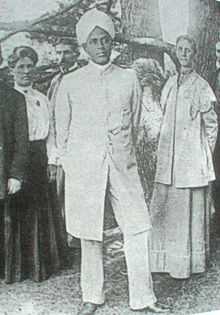Ponnambalam-Coomaraswamy family
The Ponnambalam-Coomaraswamy family was an immensely powerful family in Sri Lanka Ceylon which many say was responsible for the 20th century rise of the Tamil Vellala caste of the island. Many members of the family have received knighthoods in the past. To this day, the family continues to be respected across the island and its members continue to hold positions of power.
History
The Ponnambalam-Coomaraswamy family is one of the most ancient and respected families in Ceylon. They are the only family with continuous historical records of members going back to the 16th century (a period before the subjugation of the Jaffna Kingdom by the Portuguese in 1619).
The family members comprised the ruling elite during the Jaffna Kingdom, Portuguese, Dutch and the British periods. Since the 17th century its members have built up Sri Lanka and played a vital role in the improvement of the lives of many Sri Lankans.
During the 20th century its members were instrumental in negotiating Sri Lanka's independence from Great Britain.
Ponnampalam family
Madava Mudaliyar (birth around late 1580s-1600) is the oldest patriarch of the family.
His son was Kathirkama Mudali.
His son was Ulakanadar Mudaliyar
Ulakanadar Mudaliyar's son was named Mathar Mudaliyar.
Lohanada Mudaliyar's direct descendant Ponnampalam Mudaliyar married Sir Muttu Coomaraswamy's sister.
Members of the Ponnampalam family are of aristocratic origin.
Coomaraswamy family
Sir Muttu Coomaraswamy's father, Arumugampillai Coomaraswamy (1783–1836) from Point Pedro joint the seminary that Governor North started for producing interpreters. Coomaraswamy passed out and served as an interpreter from 1805. He was rewarded by the Governor with a Mudaliyar position at the age of 26 and became the Jaffna Tamil with the highest government appointment. He played a critical role as the Tamil-English interpreter when the Kandyan king Sri Wickrama Rajasinghe was captured in 1815. He was rewarded with a gold chain and medal by Governor Brownrigg in 1819 for loyal service to the British crown.[1]
There were allegations that he was not from the Vellala caste.[2] James Rutnam's research has shown that Coomaraswamy's Father was Arumugampillai, a South Indian, who had migrated to Gurudavil in Jaffna. (Tribune 1957). But James Rutnam does not have any conclusive evidence or documents to prove this claim.

Arunachalam Ponnambalam’s (1814–87) step Father Ariyaputhira was Coomaraswamy’s brother-in-law and in 1844 Ponnambalam married Coomaraswamy’s daughter Selachchi.
Ponnambalam was appointed cashier of the Colombo Kachcheri in 1845 and deputy Coroner for Colombo in 1847. Many leading Englishmen were his friends and it transpired in the 1849 Parliamentary Commission that he used to lend money to government officials.[3]
His three sons P. Coomaraswamy (1849–1905), P. Ramanathan (1851–1930) and P. Arunachalam (1853–1926) were national figures and two of them, P. C. and P. A. married two daughters of Namasiyayam, an extremely successful broker. This closely related and endogamous clan emerged as the pre-eminent Tamil family of the country and rose to national elite status.[4]
Despite their anglicized background which propelled their rise, the family presented a staunch Hindu appearance and assumed the role of patrons of the Vellalas in Colombo. However many of its members; Muttu Coomaraswamy, P. Coomaraswamy, P. Ramanathan married western women. Ananda Coomaraswamy was married four times to western women.
They helped many young Tamils to secure employment in English banks and mercantile establishments. On the death of Mudaliyar Coomaraswamy’s wife in 1897, the leading daily, The Ceylon Independent wrote "to her and her husband, almost every important Hindu family in the city owes its rise."
Notable members of the family
- Arumugampillai Coomaraswamy (1783-1836), Gate Mudaliyar, Member of Legislative Council
- Sir Muthu Coomaraswamy CCS FRGS (1833-1879), Member of Legislative Council + Elizabeth Clay Beeby
- Ananda Coomaraswamy (1877-1947)
- Sellachchi Coomaraswamy + A. Ponnambalam (1814-1887), Mudaliyar of the Governor's Gate
- P. Coomaraswamy (1849-1906), Member of Legislative Council
- Sir Ponnambalam Ramanathan KCMG QC (1851-1930), Solicitor General of British Ceylon, Member of Legislative Council + Leelawathy Ramanathan (1870-1953)
- Sivagamasundari + S. Natesan, Member of Parliament, Member of State Council, Senator
- Sir Ponnambalam Arunachalam KCMG CCS (1853-1924), Member of Executive Council, Member of Legislative Council + Swarnambal Namasivayam
- Arunachalam Padmanabha
- Sir Arunachalam Mahadeva KCMG (1888-1969), Government Minister, Member of Legislative Council, Member of State Council, High Commissioner to India
- Balakumar (Baku) Mahadeva
- Arunachalam Ramanathan
- Pathmavathy Arunachalam + Sir S. Pararajasingam, Senator
- Pararajasingham Nadesan
- Lalithambikai (-2005) + M. Swaminathan
- D. M. Swaminathan (1945-), Member of Parliament, Governor of Western Province
- Sir Muthu Coomaraswamy CCS FRGS (1833-1879), Member of Legislative Council + Elizabeth Clay Beeby